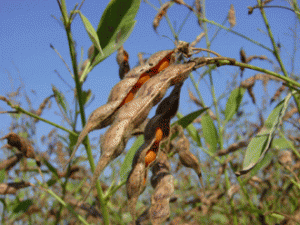By Amanda Stone
The pigeonpea has recently begun to provoke groundbreaking research for its versatility, productivity, high nutritional value, and subsequent potential to assure increased food security for millions of Asians and Africans.

This small plant is grown by subsistence farmers in warm semi-arid and sub-humid tropics, often in poor soils with little to no chemical inputs thanks to its hardiness and drought-tolerance. Historians believe the pigeonpea originated in India and then traveled to East Africa and up the Nile Valley to West Africa. Today, the food is a staple for diets in India, southern and eastern Africa, and Central America. It’s also used extensively as a cover crop, to create a hedge or windbreak, or as green manure in many sustainable farming systems and home gardens in the tropics and subtropics because of its ability to grow in warm temperatures.
The pigeonpea can help improve food security because it requires minimal water or inputs, can cope with poor soil and little water, yet still produces yields of grain that contain more than 20 percent protein, which is especially important for countries facing hunger and malnutrition
In addition to its nutritious and hardy benefits, it is also a nitrogen-fixing legume which gives it great potential to improve soil quality and–when grown together with other pasture plants–to create a highly fertile, productive and sustainable livestock feeding system. The leaves, flowers, seed pods and peas all provide a nutritious animal fodder, not to mention attracting bees that help it to self-propagate. When planted around young fruit trees they provide shelter without over-shading and the trimmings can be used as mulch with the nitrogen from its root nodules nourishing the tree.
This protein-packed little legume, if cultivated more broadly and in collaboration with other plants, has the potential to prevent hunger and improve not only farmer’s abilities to feed their families, but also their incomes. The International Crops Research Institute ICRISAT claims that if there were only one legume that assures food security in the semi-arid tropics, it would be the pigeonpea.
Amanda Stone is Nourishing the Planet’s Communications Assistant.

Danielle Nierenberg, an expert on livestock and sustainability, currently serves as Project Director of State of World 2011 for the Worldwatch Institute, a Washington, DC-based environmental think tank. Her knowledge of factory farming and its global spread and sustainable agriculture has been cited widely in the New York Times Magazine, the International Herald Tribune, the Washington Post, and
other publications.
Danielle worked for two years as a Peace Corps volunteer in the Dominican Republic. She is currently traveling across Africa looking at innovations that are working to alleviate hunger and poverty and blogging everyday at Worldwatch Institute’s Nourishing the Planet. She has a regular column with the Mail & Guardian, the Kansas City Star, and the Huffington Post and her writing was been featured in newspapers across Africa including the Cape Town Argus, the Zambia Daily Mail, Coast Week (Kenya), and other African publications. She holds an M.S. in agriculture, food, and environment from Tufts University and a B.A. in environmental policy from Monmouth College.








